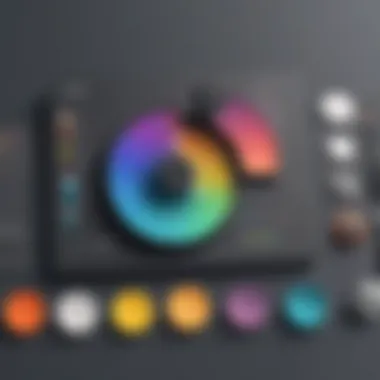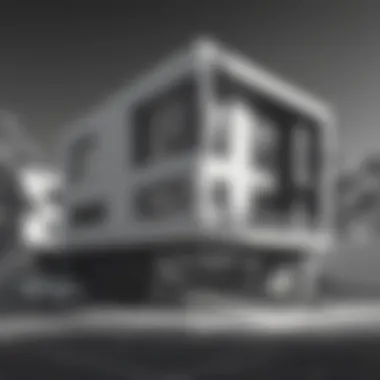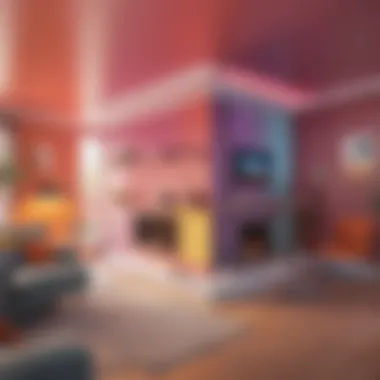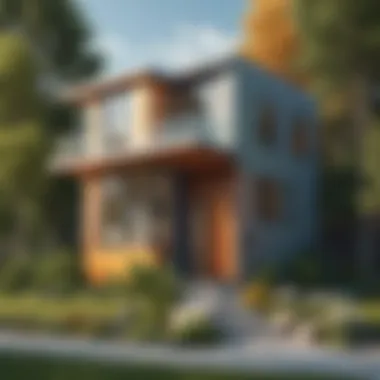Unveiling the Spectrum: A Journey Through House Painting Colors


House painting offers a myriad of color choices to transform the exterior, making it essential to delve into the world of hues to enhance curb appeal and the overall look of your abode. From classic neutrals to vibrant, eye-catching tones, the selection process encompasses various aspects that significantly influence the final outcome of your home's visual aesthetic. This comprehensive guide will navigate through the intricate realm of color choices, taking into account factors such as color psychology and architectural styles to assist in making a well-informed decision that aligns with your design preferences and complements the structural components of your dwelling.
Introduction
Painting a house's exterior is a pivotal decision that can significantly impact its overall look and feel. The color you choose carries immense weight, as it not only reflects your personal style but also affects the property's curb appeal and value. Choosing the right color can transform a mundane facade into a stunning visual masterpiece that stands out in the neighborhood. In this comprehensive guide, we will delve into the diverse world of house painting colors, exploring a myriad of options to help you make an informed and aesthetically pleasing choice for your home.
Understanding the Importance of Exterior Colors
The exterior color of a house is like its calling card, setting the tone for what lies inside. It creates the first impression and speaks volumes about the homeowner's taste and personality. Neutrals evoke a sense of elegance and timelessness, making a house appear sophisticated and refined. On the other hand, bold and vibrant hues exude energy and personality, adding a pop of color that catches the eye. Understanding how different colors evoke varying emotions and perceptions is crucial in creating the desired ambiance for your home's exterior.
Factors Influencing Color Choice
Several factors come into play when deciding on the perfect color for your house's exterior. The architectural style of the home is a key consideration, as certain colors complement specific architectural elements better than others. Climate and location also play a role, with darker colors absorbing more heat and lighter colors reflecting it. Additionally, the surrounding landscape and neighborhood aesthetic should be taken into account to ensure your home harmonizes with its environment. Personal preferences, cultural influences, and color trends further guide the color selection process, making it a multifaceted decision that requires careful thought and consideration.
Neutral Shades
In the realm of house painting, neutral shades stand out as a versatile and timeless choice for exterior color palettes. These hues play a crucial role in balancing the overall aesthetic appeal of a home, offering a sophisticated and understated elegance that can enhance various architectural styles. Neutral shades, including whites, creams, grays, and beiges, provide a harmonious canvas for other design elements while ensuring a sense of visual unity and coherence. When considering neutral shades for your home, it is essential to assess factors like natural lighting, surrounding landscape, and the desired impression. Whites and creams exude a classic and refined charm, creating a sense of spaciousness and purity. Timeless grays, on the other hand, bring a modern and contemporary vibe, offering a perfect backdrop for accent colors and architectural details. Earthy beiges and taupes convey warmth and comfort, seamlessly blending with natural surroundings for a welcoming facade.
Elegant Whites and Creams
Elegant whites and creams are classic choices for exterior painting, symbolizing purity, simplicity, and sophistication. These shades reflect light beautifully, illuminating the facade and accentuating architectural features. White exteriors exude a clean and timeless appeal, making a bold statement while emphasizing the home's design elements. Cream tones, with their subtle warmth and elegance, create a welcoming and inviting atmosphere. When opting for elegant whites and creams, it is crucial to consider factors like natural light exposure, architectural style, and neighborhood aesthetics to ensure a cohesive look that enhances curb appeal. Elegant whites and creams can complement a range of home styles, from traditional to modern, making them a versatile and enduring choice for a striking exterior makeover.
Timeless Grays
Timeless grays exude sophistication and versatility, adding a contemporary touch to a home's exterior. Gray hues come in a diverse range of undertones, from cool silvers to warm greiges, allowing for customization to suit different architectural styles and personal preferences. Gray exteriors convey a sense of balance and neutrality, providing a subtle backdrop for other design elements to shine. Whether used as a primary color or an accent hue, timeless grays can create a cohesive and polished look that enhances the overall curb appeal. When exploring timeless grays for your home, consider elements like surrounding foliage, natural light patterns, and the desired visual impact to choose the perfect shade that resonates with your style and architectural design.
Earthy Beiges and Taupes


Earthy beiges and taupes evoke a sense of comfort, warmth, and tranquility, making them popular choices for homeowners seeking a grounded and inviting exterior palette. These earthy tones blend seamlessly with natural surroundings, creating a harmonious connection between the home and its environment. Beiges and taupes range from light sandy shades to deep taupe hues, offering a broad spectrum of options to complement different architectural styles and landscaping elements. Choosing earthy beiges and taupes for your home exterior requires evaluating characteristics like texture, finish, and compatibility with existing design elements. By selecting these inviting hues, you can achieve a welcoming and peaceful ambiance that enhances the overall curb appeal and visual harmony of your abode.
Bold and Vibrant Hues
When it comes to selecting colors for your house exterior, opting for bold and vibrant hues can make a significant impact. Bold colors can add a touch of personality and uniqueness, setting your home apart from the rest on the block. Vibrant hues inject energy and liveliness into the architectural design, creating a visually striking presentation. Understanding how these shades interact with light and complement different textures is crucial for achieving the desired aesthetic.
Fiery Reds and Rich Burgundies
Fiery reds and rich burgundies are colors that exude warmth and sophistication. These hues can evoke feelings of passion and strength, making them ideal for homeowners looking to make a bold statement. When considering these shades for your house exterior, it is essential to take into account the architectural style of the dwelling. Red can be a powerful color choice for traditional or contemporary homes seeking a pop of vibrancy.
Sunny Yellows and Golden Tones
Sunny yellows and golden tones bring a sense of cheerfulness and positivity to a home's facade. These colors are often associated with optimism and creativity, making them perfect for homeowners who want to create a welcoming and lively environment. Integrating yellow hues can brighten up a space and enhance the overall curb appeal, especially in areas with limited natural light.
Deep Blues and Coastal Aquas
Deep blues and coastal aquas evoke a sense of calm and serenity, reminiscent of tranquil waters and clear skies. These shades are excellent choices for coastal or beachfront properties, as they seamlessly blend with the surrounding natural elements. Blue tones lend a timeless appeal to the exterior of a house, providing a refreshing and soothing ambiance for both residents and visitors alike.
Lively Greens and Nature-inspired Colors
Lively greens and nature-inspired colors bring the beauty of the outdoors right to your doorstep. Green hues symbolize growth, renewal, and harmony, making them popular choices for eco-friendly homes or properties nestled amidst lush landscaping. Incorporating natural greens into your house paint can create a seamless connection with the environment while infusing a sense of tranquility and balance into your everyday living space.
Modern Trends and Innovative Palettes
In this section of the article, we delve into the significance of modern trends and innovative palettes in the realm of house painting. As architectural styles evolve and interior design trends shift, staying updated with modern color schemes becomes essential for homeowners looking to revamp their exteriors. Embracing modern trends not only keeps your home current and stylish but also adds a touch of creativity and uniqueness to your property.
One key benefit of adopting modern trends and palettes is the fresh perspective they offer to traditional color choices. By exploring innovative combinations and non-traditional shades, homeowners can express their individuality and create a house that stands out in the neighborhood. Moreover, modern palettes often incorporate technology-inspired hues and environmental influences, reflecting contemporary lifestyles and values.


When considering modern trends, it's crucial to factor in the architectural style of your home. Opting for a palette that complements the design elements and structural features can elevate the overall aesthetic appeal. Additionally, understanding color psychology and its impact on perception assists in making informed decisions. Whether you prefer bold, eye-catching colors or subtle, understated tones, modern trends provide a wide array of options to suit every preference and home style.
Monochromatic Schemes
Delving into the concept of monochromatic schemes, we discover a sophisticated approach to house painting that focuses on variations of a single color. Monochromatic palettes create a sense of harmony and cohesion, offering a sleek and contemporary look to your home's exterior. By playing with different shades, tints, and tones within the same color family, homeowners can achieve a timeless elegance that exudes sophistication.
One of the advantages of monochromatic schemes is their versatility. From light pastels to deep, rich tones, monochromatic palettes can adapt to various architectural styles and design preferences seamlessly. This flexibility allows for personalization while maintaining a modern and polished appearance. Additionally, monochromatic schemes are inherently calming and visually appealing, making them a popular choice for homeowners seeking a cohesive and balanced facade.
When implementing a monochromatic scheme, it's essential to consider the impact of natural light on different shades of the chosen color. Proper lighting can enhance the depth and texture of the exterior, creating visual interest and dimension. Whether opting for a monochromatic white scheme for a contemporary look or a monochromatic gray palette for a classic aesthetic, this design approach offers endless possibilities for creating a stunning exterior.
Contrasting Color Combinations
Exploring the realm of contrasting color combinations opens doors to dynamic and visually striking possibilities for house painting. By pairing colors that sit opposite each other on the color wheel, homeowners can create a vibrant and energetic exterior that grabs attention. Contrasting color schemes inject personality and character into your home, making a bold statement while showcasing your creative flair.
One of the key aspects of contrasting color combinations is the balance between primary and accent colors. While bold contrasts can add drama and emphasis, integrating neutral tones or textures can help achieve harmony and prevent overwhelming the facade. Understanding color theory and the interplay of different hues is essential in creating a cohesive yet impactful exterior that reflects your unique style.
Contrasting color combinations work well for highlighting architectural features and adding depth to the facade. Whether opting for a striking combination of black and white for a modern look or experimenting with complementary colors for a playful vibe, choosing contrasting hues can transform your home into a visual masterpiece. By carefully selecting and blending colors, homeowners can curate a distinctive and memorable exterior that exudes charm and individuality.
Metallic Finishes and Textured Effects
In the realm of house painting, exploring metallic finishes and textured effects offers a contemporary and luxurious twist to traditional exteriors. Metallic paints and finishes add a touch of opulence and sophistication to your home, creating a modern and dynamic aesthetic. With a range of metallic hues available, homeowners can customize their exterior with reflective surfaces that catch the light and create a stunning visual impact.
Utilizing textured effects like stucco, brushed metal, or weathered finishes adds depth and interest to the facade, enhancing the architectural details and creating a sense of tactile allure. Textured surfaces not only provide a unique visual appeal but also offer durability and protection against elements, ensuring long-lasting beauty for your home's exterior.
When incorporating metallic finishes and textured effects, it's important to consider the overall style and color palette of your home. Whether opting for a subtle shimmer or a bold metallic accent, harmonizing these finishes with existing elements can elevate the curb appeal and add a touch of luxury. Additionally, leveraging textured effects can help disguise imperfections on the exterior surface while adding character and dimension to the facade, resulting in a visually captivating and modern finish.
Color Psychology in Home Design


When considering the color scheme for your house, delving into the realm of color psychology is crucial. This section will shed light on the profound impact colors have on our emotions, perceptions, and overall well-being, making it an indispensable element in home design. Understanding how colors influence our psyche can significantly enhance the ambiance of our living spaces.
Color psychology in home design is not merely about aesthetic preferences; it delves deeper into the subconscious effects that different colors evoke. Each color carries its own symbolism and associations, affecting mood and behavior in varying ways. By harnessing this knowledge, homeowners can create environments that promote desired emotions and behaviors.
Exploring color psychology allows us to strategically select hues that align with the intended purpose of each room. For instance, calming blues and greens are ideal for bedrooms to promote relaxation, while energetic reds and yellows might be suitable for social areas like the living room. Choosing the appropriate color palette can significantly impact how we interact with and experience our living spaces.
Considerations about color psychology in home design extend beyond individual preferences, diving into cultural influences and universal responses to color stimuli. This section will delve into the intricate interplay between color, culture, and psychology, offering valuable insights for homeowners seeking to create harmonious and visually appealing living environments.
The Impact of Colors on Mood and Perception
Colors wield a profound influence on our mood and perception, shaping our experiences within a space. By understanding how different colors elicit emotional responses, homeowners can craft environments that evoke specific feelings and attitudes.
Warm hues such as reds, oranges, and yellows are known to energize and stimulate creativity, making them ideal for spaces intended for activity and socialization. In contrast, cool tones like blues and greens have a calming effect, promoting relaxation and concentration, making them suitable for areas where focus and tranquility are paramount. Neutral shades create a sense of balance and timelessness, offering versatility and a sophisticated backdrop for diverse design styles.
The psychological impact of colors extends beyond personal preference, influencing how visitors perceive and interact with a space. Bold and vibrant hues can make a statement and leave a lasting impression, while subtle pastels can imbue a sense of serenity and elegance. By harnessing the power of color, homeowners can curate environments that resonate with their unique sensibilities and enhance the overall aesthetic appeal of their homes.
Choosing Colors that Reflect Personal Style
Selecting colors that reflect personal style is a deeply personal and creative endeavor that allows homeowners to infuse their living spaces with individuality and character. This section will explore how color choices can be a reflection of one's personality, tastes, and lifestyle, illustrating the transformative potential of colors in home design.
Personal style plays a pivotal role in determining color preferences, with some drawn to bold statements and eclectic palettes, while others prefer muted tones and understated elegance. Understanding one's design aesthetic and the ambiance they wish to cultivate is essential in choosing colors that align with their personal style and vision for their home.
When selecting colors that reflect personal style, considerations such as texture, finish, and lighting come into play. Matte finishes lend a contemporary, understated look, while metallic accents add a touch of luxury and sophistication. Natural light can transform the appearance of colors, influencing how they are perceived throughout the day and in different seasons.
By aligning color choices with personal style, homeowners can curate spaces that resonate with their identity and create a sense of belonging. Whether opting for bold and daring hues or timeless neutrals, the color palette of a home reflects the essence of its inhabitants, making it a canvas for self-expression and creativity.
Conclusion
In the realm of house painting, the choice of color plays a pivotal role in defining the essence and appeal of your abode. After delving into the vast spectrum of colors, understanding their impact on mood, perception, and architectural styles, arriving at the right color for your home is a decision of utmost significance. The concluding segment of this article serves as a compass, guiding you towards making an informed choice that synchronizes with your personal style and the aesthetic language of your dwelling. As you traverse through the intricacies of color psychology and the influence of hues on curb appeal, remember that the color you choose is not merely a coat of paint but a reflection of your taste and the personality of your home.
Final Thoughts on Selecting the Perfect Color for Your Home
A crucial aspect of embarking on the journey of painting your home lies in selecting the perfect color scheme that resonates with your vision and harmonizes with the architecture of your house. The color palette you opt for sets the tone for the ambiance of your living space, encapsulating emotions, and creating a lasting first impression. Considering the geographic location, architectural style, and natural surroundings of your home is paramount in making a choice that complements the existing aesthetics. Whether you lean towards the serene neutrality of whites, greys, and beiges or gravitate towards the bold vibrancy of reds, yellows, blues, and greens, each shade has a story to tell. It is essential to visualize the interplay of light and shadows on your selected color to ensure that it embodies the desired essence throughout the day. Experimenting with sample patches, observing them during different times of the day, and analyzing how they blend with the landscape can aid in making an informed and aesthetically pleasing decision. Remember, the perfect color is not merely about trends or personal preferences but a harmonious fusion of individuality, architecture, and environmental context.



